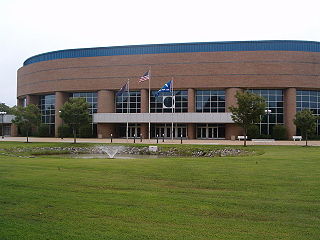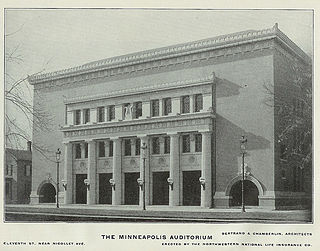
Welsh–Ryan Arena is a 7,039-seat multi-purpose arena in Evanston, Illinois, United States, near the campus of Northwestern University. It is home to four Northwestern Wildcats athletic teams: men's basketball, women's basketball, women's volleyball, and wrestling. It is located inside McGaw Memorial Hall, to the north of Ryan Field.

Municipal Auditorium is a multi-purpose facility located in Kansas City, Missouri. It opened in 1935 and features Streamline Moderne and Art Deco architecture and architectural details.
McKenzie Arena is the primary basketball arena for the University of Tennessee at Chattanooga (UTC) in Chattanooga in the U.S. state of Tennessee. It replaced Maclellan Gymnasium, a 4,177-seat gymnasium now used for women's volleyball and wrestling. Originally called UTC Arena, it was renamed McKenzie Arena on February 21, 2000, in honor of athletic supporters Toby and Brenda McKenzie of Cleveland, Tennessee. The arena opened on October 8, 1982. It was designed by Campbell & Associates Architects with David J. Moore as the on-site architect/construction administrator.

The Littlejohn Coliseum is a 9,000-seat multi-purpose arena in Clemson, South Carolina, United States. It is home to the Clemson University Tigers men's and women's basketball teams. It is also the site of Clemson graduations and the Clemson Career Fair. It is owned and operated by Clemson University and hosts more than 150 events per year including concerts, trade shows, galas, and sporting events.

Alfond Arena is a 5,124-seat multi-purpose arena in Orono, Maine, United States. The arena opened in 1977. It is home to the University of Maine Black Bears ice hockey teams. It is recognizable for its distinctive hyperbolic paraboloid architecture. The multi-angular roof design can also be found at Pavilion at Villanova University, the Brown University Smith Swim Center and the Flynn Recreation Complex at Boston College. It was expanded from its original capacity of 3,800 in 1992 in order to accommodate more spectators and bring the basketball team back from its temporary home at the Bangor Auditorium. More skyboxes have been added since then, so the arena's capacity has been reduced. A new scoreboard was installed during the summer of 2008. It is named for Harold Alfond, a longtime Maine booster, whose name also adorns Alfond Stadium, the school's main outdoor stadium.

Tom Gola Arena, The Tom, The Gola, is a 3,400-seat multi-purpose arena in Philadelphia, Pennsylvania situated inside the TruMark Financial Center. It is home to the La Salle University Explorers men's and women's basketball teams as well as its volleyball team. It is named after former Explorers captain and head coach Tom Gola, currently in the Naismith Memorial Basketball Hall of Fame.

The Robins Center is a 7,201-seat multi-purpose arena in Richmond, Virginia. Opened in 1972, the arena is home to the University of Richmond Spiders basketball. It hosted the ECAC South men's basketball tournament in 1983. It is named for E. Claiborne Robins Sr, class of 1931, who, along with his family, have been leading benefactors for the school. The opening of the Robins Center returning Spider basketball to an on-campus facility for the first time since the mid-1940s when it outgrew Millhiser Gymnasium. In the intervening decades, the Spiders played home games in numerous locations around the Richmond area, including the Richmond Coliseum (1971–1972), the Richmond Arena (1954–1971), the Benedictine High School gymnasium (1951–1954), Grays' Armory (1950–1951) and Blues' Armory (1947–1950). The Robins Center arena serves as the location of the University of Richmond's commencement exercises and hosted a 1992 Presidential debate involving Bill Clinton, George H. W. Bush, and Ross Perot.

Hampton Convocation Center is a 7,200-seat multi-purpose arena in Hampton, Virginia. It was built in 1993 and is home to the Hampton University Pirates basketball team. The arena replaced Holland Hall gymnasium, which holds women's volleyball matches and tournaments. The construction cost was about $4 million-$5 million.

The William H. Pitt Health and Recreation Center is a 2,062-seat multipurpose arena in Fairfield, Connecticut on the campus of Sacred Heart University. It was opened in August 1997 and is home to Sacred Heart University men's and women's basketball, men's and women's volleyball, men's wrestling and fencing. It hosted the finals of the 2008 Northeast Conference men's basketball tournament.
Tiger Arena is a 5,000-seat multi-purpose arena in Savannah, Georgia, United States. It is home to the Savannah State University Tigers men's and women's basketball teams and women's volleyball team. Tiger Arena has previously hosted the Georgia High School Association boys and girls playoffs, the annual Georgia Athletic Coaches Association's North-South All-Star Game (2003-2008), and the Savannah Holiday Classic high school girls basketball tournament. It was also home to the Savannah Steam of American Indoor Football.

Minneapolis Auditorium was an indoor arena in Minneapolis, Minnesota. It hosted the NBA's Minneapolis Lakers from 1947 until they moved to the Minneapolis Armory in 1959. The arena held 10,000 people and was built in 1927. The building fell into obscurity after the opening of the Met Center in suburban Bloomington. It was demolished in 1988 to make way for the Minneapolis Convention Center.

Denver Auditorium Arena was an indoor arena located at the corner of 13th and Champa Streets in Denver, Colorado. It was constructed as the Denver Municipal Auditorium in 1908 during the administration of Denver Mayor Robert W. Speer. The building was opened on July 7, 1908, and was the site of the 1908 Democratic National Convention.

Alumni Coliseum is a multi-use sports arena located on the campus of Eastern Kentucky University in Richmond, Kentucky.

Walsh Gymnasium is a multi-purpose arena in South Orange, New Jersey on the campus of Seton Hall University. The arena opened in 1941 and can seat 1,316 people. It was home to the Seton Hall Pirates men's basketball team before they moved to the Meadowlands in 1985 and then Prudential Center in 2007. Currently, the arena hosts the women's basketball and volleyball teams, but continues to host men's basketball for preseason exhibitions, postseason invitational games such as early rounds of the NIT, and occasionally a regular season non-conference game if there is a conflict with Prudential Center's event schedule. The building is part of the Richie Regan Recreation & Athletic Center, and, like the school's main library, is named for Rev. Thomas J. Walsh, Fifth Bishop of Newark and former President of the Board of Trustees.

William L. White Auditorium, commonly known as White Auditorium, is a 5,000 seat multi-purpose arena in Emporia, Kansas. It is home to the Emporia State University men's and women's basketball teams, as well as the volleyball team.

The John W. Pope Jr. Convocation Center is a multi-purpose arena in Buies Creek, North Carolina. The arena, Gore Arena, is located on the campus of Campbell University and hosts the university's basketball, volleyball, and wrestling programs. It is named for Gilbert Craig Gore, the late son of a Campbell alum. The John W. Pope Jr. Convocation Center is a part of the expansion plan of Campbell's athletic facilities, which includes a new football stadium and renovations to existing Taylor Field of the baseball program. The John W. Pope Jr. Convocation Center replaced Carter Gymnasium, which was the second smallest gymnasium in Division I Basketball with just 947 seats, second only to Charleston Southern's Fieldhouse which holds 750. The John W. Pope Jr. Convocation Center also host events such as the universities commencement ceremonies and other university related events.

The Alfred Lawson Jr. Multipurpose Center and Teaching Gymnasium is a 9,639-seat multi-purpose arena in Tallahassee, Florida on the Campus of Florida A&M University. It was built in 2009 and it is home to the Florida A&M men's and women's basketball teams and women's volleyball team. The arena replaced Jake Gaither Gymnasium, which is a 3,365-seat multi-purpose arena. The Al Lawson Center is the second biggest arena in Tallahassee, behind the 12,500-seat Donald L. Tucker Civic Center. The official ribbon cutting ceremony was April 8, 2009.
The Waterman Gymnasium was the first on-campus gymnasium at the University of Michigan in Ann Arbor, Michigan. The building was the first home of the Michigan Wolverines men's basketball team. The building stood at the corner of North University Avenue and East University Avenue, at the northeast corner of the original campus.
The original Harmon Gymnasium was a gymnasium on the campus of the University of California in Berkeley, California. It was the fourth building built on campus, after North Hall, South Hall and Bacon Hall, and the first built with funds from a private donor. In 1878, Albion Keith Paris Harmon, an Oakland businessman, donated $15,000 to the University for the construction of a gymnasium and assembly hall, which was to be named in his honor. In 1879 the octagonal wooden building opened, north of Strawberry Creek.
The Weaver Gymnasium, formally known as the Weaver Health Building, is an on-campus gymnasium on the campus of Eastern Kentucky University in Richmond, Kentucky. It was opened in 1931 and was named for Charles F. Weaver who served for twelve years on EKU's Board of Regents and established two of the first financial awards at EKU. The building, which houses a pool, gymnasium and dance studios, was the third home of the Eastern Kentucky Colonels men's basketball team, replacing a building known as "The Barn." During their time in Weaver, the Maroons had a record of 225-51 overall and reached the NAIA Men's Basketball Championships twice, in 1945 and 1946, and the 1953 and 1959 NCAA tournament, as well as winning two regular season Ohio Valley Conference titles and two conference tournaments. The last Maroons game held in Weaver was a 96-78 loss to the Louisville Cardinals. The building was replaced in 1963 with the Alumni Coliseum, with a revenge win against the same Cardinals. The building now serves as a site for campus fitness and recreation.

















